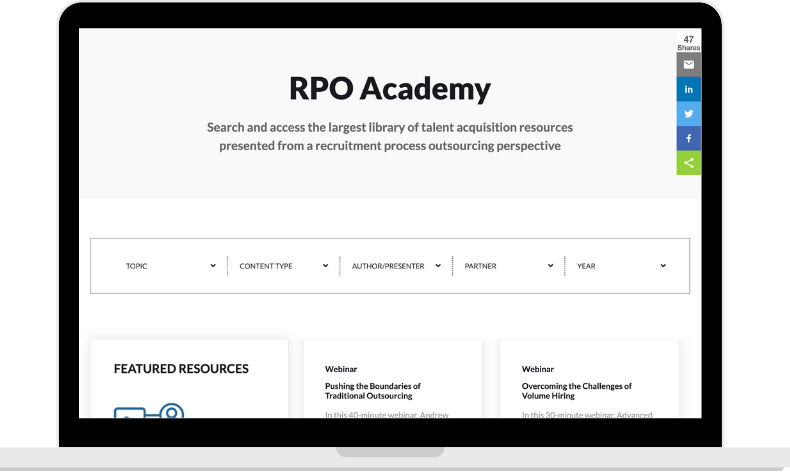
Ninety percent of employees use generative AI without enterprise protection, creating what Jordan Morrow calls "Shadow AI"—unprotected systems that compromise sensitive candidate data and intellectual property. Only 40 percent of enterprises have purchased protected AI licenses, leaving recruitment organizations exposed to security risks and compliance failures.
At the 2025 Annual RPOA Conference, Jordan Morrow, Senior Vice President of Data and AI Transformation at AgileOne, outlined how recruitment leaders can move beyond superficial AI adoption to build strategic value. Having helped pioneer data literacy and assisted organizations like the United Nations in building their data capabilities, Morrow provided strategic insights for enterprise AI implementation.
Major takeaways for business leaders:
- Shadow AI creates liability: Employees bypass corporate systems, exposing personally identifiable information through unprotected public models.
- Traditional ROI metrics fail for AI: Velocity of insight—speed to effective decisions—measures AI value better than efficiency gains.
- Human skills dominate 2030 workforce needs: Six of the top 10 fastest-growing skills are human-centric, not technical.
Shadow AI Creates Enterprise Security and Compliance Risks
The gap between AI usage and enterprise protection exposes recruitment organizations to data theft and regulatory violations. Morrow cited companies like Nike and Citibank that shut down AI access after employees input proprietary information into public models. Workers switched to personal devices to bypass restrictions.
Morrow said organizations that shut down AI rather than building protected systems miss the strategic opportunity. Enterprise AI infrastructure governs data protection to eliminate compliance exposure. Prohibition policies drive underground usage rather than solving security challenges.
Among conference attendees implementing AI, only one person had formal AI training. Morrow noted that 90 to 99 percent of workers lack degrees in data or AI. Every organization races to implement these technologies without preparation.
Four Strategic Components Define AI-Integrated Recruitment
Morrow outlined four domains requiring restructuring, moving beyond superficial feature additions to native AI enablement.
- Talent intelligence replaces talent management. Morrow said AI agents will replace workers when built properly, making the challenge about workforce rediscovery rather than headcount reduction. He cited Salesforce, which replaced 4,000 of 9,000 customer service representatives with agentic AI, proving that AI directly replaces jobs.
- Predictive analytics enable proactive strategies. Morrow noted organizations neglect machine learning in their rush toward generative AI. He works with clients building predictive attrition models for contingent workforces exceeding 1,700 hires annually. Strategic analytics forecast workforce gaps to enable proactive hiring strategies months before needs emerge.
- Deep process integration surpasses feature additions. Morrow distinguished between organizations that are AI-native—transforming how people work—and those adding features without strategic integration. True AI enablement augments worker capabilities throughout workflows.
- AI functions as a strategic partner. Morrow said workers should view AI as a PhD-level advisor for daily operations. This makes AI synonymous with work rather than separate from it.
AI-Native Systems Deliver Strategic Value Beyond Feature Sets
Morrow expressed that the distinction between AI-native systems and AI features determines competitive advantage. Features can function as gimmicks. AI-native systems transform business models by augmenting core processes to deliver measurable outcomes.
Morrow drew parallels to the 2000 internet bubble, when overvalued companies burst while the underlying technology remained transformative. He said organizations must shift from proof of concept to proof of value. Proof of concept demonstrates that something works. Proof of value confirms building the right things.
Morrow warned that the challenge intensifies as AI-native startups emerge to compete against established firms, making incremental improvements. Organizations must think entrepreneurially about redefining recruitment.
Velocity of Insight Replaces Traditional ROI Metrics
Morrow warns that speed alone fails to measure AI value. Organizations might become faster at producing poor outcomes. He said the metric that matters measures how teams make effective decisions using available data and AI.
Morrow developed a mathematical formula comparing the time to generate insights using AI versus human effort alone. This velocity of insight metric measures decision speed, replacing traditional ROI calculations that fail for AI implementations. Traditional calculations fail because AI functions as part of a process, not an entire process.
Morrow said organizations should also measure cognitive load reduction and burnout prevention. He experienced depression and burnout in 2019 while building the data literacy field. In today's stagnant hiring market, these metrics apply to candidates experiencing anxiety over competition.
Advanced Applications Extend Beyond Email Management
Morrow outlined strategic applications extending beyond email review and document analysis.
Morrow said recruiters should position themselves as talent strategists who use AI to fill skill gaps. This elevates client relationships through advisory services. He distributes metrics two weeks before meetings to shift meeting focus to strategy and eliminate presentation waste. Meeting time focuses on accountability rather than data delivery.
Morrow said that during the current low-fire, low-hire market stage, recruitment specialists should advise organizations on future needs using AI to predict requirements. Large language models (LLMs) analyze organizational talent data across HR systems to identify future hiring needs. He said organizations not using generative AI for market research and competitive analysis miss strategic advantages in negotiations.
Human Skills Dominate Future Workforce Requirements
Morrow cited 2025 World Economic Forum data showing six of the top 10 fastest-growing skills by 2030 are human-centric. Creative thinking, resilience, flexibility, curiosity, lifelong learning, and leadership rank alongside AI and big data as critical capabilities.
Morrow created the 3Cs of data literacy—curiosity, critical thinking, and creativity—to address educational gaps. He referenced Johann Hari's research showing that teenagers focus on tasks for only 90 seconds while adults manage three minutes. Morrow said organizations must help candidates and employees think critically rather than process information.
Narrative Construction Drives Adoption More Than Data Quality
Morrow said data fails to change minds despite its accuracy. He admits this paradox despite helping invent the data literacy field. Narrative drives belief and action.
Morrow stressed that recruitment professionals should become "walking Pixar storytellers" who use AI to build narratives around data points. He cited Pixar's Wall-E, which features 45 to 50 minutes of no dialogue yet remains engaging through storytelling. One critical metric means nothing without a narrative context that drives adoption.
AI narrative synthesis converts data to stories, reducing synthesis time from three to five hours to three to five minutes. Morrow suggests asking generative AI to create narratives for specific audiences and data points. This helps professionals understand how multiple data points relate to client needs.
Engineered Intelligence Combines Analytical and Emotional Processing
Morrow introduced engineered intelligence, which combines data and AI with both IQ and EQ. While AI might recommend laying off 50 percent of staff to boost shareholder value, this framework applies analytical and emotional processing to prevent value-destroying decisions. Cultural impact and reputational damage reduce value despite short-term financial gains.
Morrow redefines "human in the loop" beyond oversight to encompass questioning AI recommendations using both types of intelligence. This approach takes three minutes per decision but produces better outcomes for organizations, clients, and candidates.
Implementation Requires Strategic Change Management
Morrow said organizations should focus on explaining why AI matters, creating communities where people share successes and failures, establishing pilot programs with champions, and pursuing proof of value rather than proof of concept.
Morrow outlined three actions that drive adoption. First, challenge assumptions about recruitment rather than making incremental improvements. Second, apply one new generative AI use case within one week. Third, study one unfamiliar AI topic across generative AI, multimodal AI, autonomous agentic AI, and predictive analytics.
Morrow concluded that the future is not approaching—it is being built. Organizations must decide whether they shape that future or allow it to be shaped for them.
Check out the RPOA calendar of events for the annual conference and more events from the RPOA.














